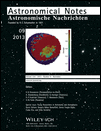Analysis of the possible Blazhko-effect Cepheid V473 Lyrae
Corresponding Author
L. Molnár
Konkoly Observatory, Research Centre for Astronomy and Earth Sciences, Hungarian Academy of Sciences, Konkoly Thege Miklós üt 15–17, H-1121 Budapest, Hungary
Konkoly Observatory, Research Centre for Astronomy and Earth Sciences, Hungarian Academy of Sciences, Konkoly Thege Miklós üt 15–17, H-1121 Budapest, HungarySearch for more papers by this authorL. Szabados
Konkoly Observatory, Research Centre for Astronomy and Earth Sciences, Hungarian Academy of Sciences, Konkoly Thege Miklós üt 15–17, H-1121 Budapest, Hungary
Search for more papers by this authorR. J. Dukes Jr.
Department of Physics and Astronomy, The College of Charleston, Charleston, SC 29424, USA
Search for more papers by this authorÁ. Győrffy
Department of Astronomy, Eötvös University, Pázmány Péter sétány 1/A, H-1117 Budapest, Hungary
Search for more papers by this authorR. Szabó
Konkoly Observatory, Research Centre for Astronomy and Earth Sciences, Hungarian Academy of Sciences, Konkoly Thege Miklós üt 15–17, H-1121 Budapest, Hungary
Search for more papers by this authorCorresponding Author
L. Molnár
Konkoly Observatory, Research Centre for Astronomy and Earth Sciences, Hungarian Academy of Sciences, Konkoly Thege Miklós üt 15–17, H-1121 Budapest, Hungary
Konkoly Observatory, Research Centre for Astronomy and Earth Sciences, Hungarian Academy of Sciences, Konkoly Thege Miklós üt 15–17, H-1121 Budapest, HungarySearch for more papers by this authorL. Szabados
Konkoly Observatory, Research Centre for Astronomy and Earth Sciences, Hungarian Academy of Sciences, Konkoly Thege Miklós üt 15–17, H-1121 Budapest, Hungary
Search for more papers by this authorR. J. Dukes Jr.
Department of Physics and Astronomy, The College of Charleston, Charleston, SC 29424, USA
Search for more papers by this authorÁ. Győrffy
Department of Astronomy, Eötvös University, Pázmány Péter sétány 1/A, H-1117 Budapest, Hungary
Search for more papers by this authorR. Szabó
Konkoly Observatory, Research Centre for Astronomy and Earth Sciences, Hungarian Academy of Sciences, Konkoly Thege Miklós üt 15–17, H-1121 Budapest, Hungary
Search for more papers by this authorAbstract
V473 Lyrae is a peculiar Galactic Cepheid, showing strong amplitude modulation that resembles the Blazhko-effect observed in RR Lyrae stars. We collected data spanning several modulation cycles and started a detailed analysis. The first results indicate that the star shows both amplitude and phase modulations with an average period of 1204 days, but both the cycle length and the strength of the modulation are subjected to considerable variations. A possible quintuplet component in the Fourier spectrum and additional period changes were also detected. (© 2013 WILEY-VCH Verlag GmbH & Co. KGaA, Weinheim)
References
- Arellano Ferro, A. 1984, MNRAS, 209, 481
- Arellano Ferro, A., Parrao, L., Schuster, W., et al. 1990, A&AS, 83, 225
- Auvergne, M. 1986, A&A, 159, 197
- Benkő, J. M., Kolenberg, K., Szabó, R., et al. 2010, MNRAS, 409, 1585
- Berdnikov, L. N., & Pastukhova, E. N. 1994, Astronomy Lett., 20, 720
- Berdnikov, L. N., Ignatova, V. V., Pastukhova, E. N., & Turner, D. G. 1997, Astronomy Lett., 23, 177
- Berdnikov, L. N. 2008, VizieR On-line Data Catalog, 2285, 0
- Breger, M. 1969, ApJS, 19, 79
- Breger, M. 1981, ApJ, 249, 666
-
Breger, M. 2006, Communications in Asteroseismology, 148, 52
10.1553/cia148s52 Google Scholar
- Bruntt, H., Evans, N. R., Stello, D., et al. 2008, ApJ, 683, 433
- Buchler, J. R., & Kolláth, Z. 2011, ApJ, 731, 24
- Burki, G. 1984, HR7308 V473-LYRAE – the Strangest Cepheid, in Observational Tests of the Stellar Evolution Theory, ed. A. Maeder & A. Renzini, IAU Symp. 105 (D. Reidel Publishing Company, Dordrecht), 453
- Burki, G., & Mayor, M. 1980, A&A, 91, 115
- Burki, G., Mayor, M., & Benz, W. 1982, A&A, 109, 258
- Burki, G., Schmidt, E. G., Arellano Ferro, A., et al. 1986, A&A, 168, 139
- Cabanela, J. E. 1991, Journal American Association of Variable Star Observers, 20, 54
- Fabregat, J., Suso, J., & Reglero, V. 1990, MNRAS, 245, 542
- Fernie, J. D. 1982, PASP, 94, 537
- Eggen, O. J. 1985, AJ, 90, 1297
- ESA 1997, The Hipparcos and Tycho Catalogues, ESA SP-1200, Noordwijk
- Feuchtinger, M., Buchler, J. R., & Kolláth, Z. 2000, ApJ, 544, 1056
- Guggenberger, E., Kolenberg, K., Chapellier, E., et al. 2011, MNRAS, 415, 1577
- Guggenberger, E., Kolenberg, K., Nemec, J. M., et al. 2012, MNRAS, 424, 649
- Henriksson, G. 1983, Uppsala Obs. Rep. 26
-
Ignatova, V. V., & Vozyakova, O. V. 2000, Astronomical and Astrophysical Transactions, 19, 133
10.1080/10556790008241357 Google Scholar
- Jurcsik, J., Sódor, Ä., Szeidl, B., et al. 2008, MNRAS, 393, 1553
- Jurcsik, J., Sódor, Ä., Szeidl, B., et al. 2009, MNRAS, 400, 1006
- Kiss, L. L. 1998, MNRAS, 297, 825
- Koen, C. 2001, MNRAS, 322, 97
- Kolláth, Z., & Csubry, Z. 2006, Mem. Soc. Astron. Ital., 77, 109
- Kovács, G. 2009, The Blazhko Effect, in Stellar Pulsation: Challenges for Theory and Observation, ed. J.A. Guzik & P.A. Bradley, AIPC 1170 (AIP, Melville), 261
-
Lenz, P., & Breger, M. 2005, Communications in Asteroseismology, 146, 53
10.1553/cia146s53 Google Scholar
- Moskalik, P., & Kołaczkowski, Z. 2009, MNRAS, 394, 1649
- Percy, J. R., & Evans, N. R. 1980, AJ, 85, 1509
- Sódor, Á. 2009, Changes in Mean Global Physical Parameters of Blazhko RR Lyrae Stars Derived from Multicolor Photometry, in Stellar Pulsation: Challenges for Theory and Observation, ed. J.A. Guzik & P.A. Bradley, AIPC 1170 (AIP, Melville), 294
- Stothers, R. B. 2009, ApJ, 696, L37
- Van Hoolst, T., & Waelkens, C. 1995, A&A, 295, 361




